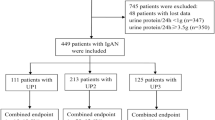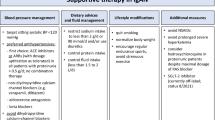Abstract
Background
Crescent formation in immunoglobulin A nephropathy (IgAN) has been demonstrated to be a risk factor for worse outcomes. For IgAN patients with 0–25% crescentic glomeruli (C1), whether corticosteroids (CS) can improve the prognosis remains unclear. We tried to investigate the need for using CS in IgAN patients with C1 in different proteinuria levels.
Methods
A total of 120 eligible IgAN patients with C1 from two academic medical centers were retrospectively studied, and 57 (47.5%) received CS. Patients were grouped according to with or without CS. The outcomes were the rate of estimated glomerular filtration rate (eGFR) decline (ml/min per 1.73 m2/year) and a composite outcome (50% decrease in eGFR, end stage renal disease (ESRD) or death due to kidney disease). The progression of adverse outcome among them were analyzed in Kaplan–Meier curve. The independent significance of CS on renal outcome or eGFR decline rate were analyzed by multivariable Cox regression or linear regression.
Results
Unadjusted Kaplan–Meier showed that the outcome of treated patients was better than that of the untreated patients. Multiple Cox regression and linear regression analysis found that CS independently protected the renal outcome and decreased the eGFR decline rate. In the subgroup analysis, multivariate linear regression showed that CS decreased the eGFR decline rate both in proteinuria ≥ 1 g/day and < 1 g/day.
Conclusions
CS protected the renal outcome and slowed the eGFR decline rate of IgAN patients with C1, it also decreased the eGFR decline rate even in those with initial proteinuria < 1 g/day.




Similar content being viewed by others
References
Roberts IS. Pathology of IgA nephropathy. Nat Rev Nephrol. 2014;10:445–54.
Coppo R. Clinical and histological risk factors for progression of IgA nephropathy: an update in children, young and adult patients. J Nephrol. 2017;30:339–46.
Coppo R. Treatment of IgA nephropathy: recent advances and prospects. Nephrol Ther. 2018;14(Suppl 1):S13–21.
Lv J, Xu D, Perkovic V, Ma X, Johnson DW, Woodward M, et al. Corticosteroid therapy in IgA nephropathy. J Am Soc Nephrol. 2012;23:1108–16.
Yang D, He L, Peng X, Liu H, Peng Y, Yuan S, et al. The efficacy of tonsillectomy on clinical remission and relapse in patients with IgA nephropathy: a randomized controlled trial. Ren Fail. 2016;38:242–8.
Radhakrishnan J, Cattran DC. The KDIGO practice guideline on glomerulonephritis: reading between the (guide)lines–application to the individual patient. Kidney Int. 2012;82:840–56.
Rasche FM, Keller F, Rasche WG, Schiekofer S, Boldt A, Sack U, et al. Why, when and how should immunosuppressive therapy considered in patients with immunoglobulin A nephropathy? Clin Exp Immunol. 2016;186:115–33.
Tesar V, Troyanov S, Bellur S, Verhave JC, Cook HT, Feehally J, et al. Corticosteroids in IgA nephropathy: a retrospective analysis from the VALIGA study. J Am Soc Nephrol. 2015;26:2248–58.
Moroni G, Ponticelli C. Rapidly progressive crescentic glomerulonephritis: early treatment is a must. Autoimmun Rev. 2014;13:723–9.
Chen S, Tang Z, Xiang H, Li X, Chen H, Zhang H, et al. Etiology and outcome of crescentic glomerulonephritis from a single center in China: a 10-year review. Am J Kidney Dis. 2016;67:376–83.
Cai F, Han F, Wang H, Han H, Le J, Lan L, et al. The crescentic implication of renal outcomes in proliferative lupus nephritis. J Rheumatol. 2018;45:513–20.
Rianthavorn P, Chacranon M. Long-term renal outcome in pediatric glomerulonephritis associated with crescent formation. Clin Exp Nephrol. 2018;22:661–7.
Zhang X, Shi S, Ouyang Y, Yang M, Shi M, Pan X, et al. A validation study of crescents in predicting ESRD in patients with IgA nephropathy. J Transl Med. 2018;16:115.
Park S, Baek CH, Cho H, Yu MY, Kim YC, Go H, et al. Glomerular crescents are associated with worse graft outcome in allograft IgA nephropathy. Am J Transpl. 2018;19:145–55.
Tanaka Y, Nakashima Y, Mima T, Ohya M, Yamamoto S, Kobayashi S, et al. Effects of cyclophosphamide pulse therapy on the clinical and histopathological findings, particularly crescent formation, in a patient with adult-onset steroid-refractory Henoch-Schonlein purpura nephritis. Intern Med. 2015;54:2207–11.
Zhang W, Yuan M, Hong L, Zhou Q, Chen W, Yang S, et al. Clinical outcomes of lupus nephritis patients with different proportions of crescents. Lupus. 2016;25:1532–41.
Trimarchi H, Barratt J, Cattran DC, Cook HT, Coppo R, Haas M, et al. Oxford classification of IgA nephropathy 2016: an update from the IgA nephropathy classification working group. Kidney Int. 2017;91:1014–21.
Lv J, Zhang H, Wong MG, Jardine MJ, Hladunewich M, Jha V, et al. Effect of oral methylprednisolone on clinical outcomes in patients with IgA nephropathy: the TESTING randomized clinical trial. JAMA. 2017;318:432–42.
Barnes PJ. Glucocorticoids. Chem Immunol Allergy. 2014;100:311–6.
Levey AS, Stevens LA, Schmid CH, Zhang YL, Castro AR, Feldman HI, et al. A new equation to estimate glomerular filtration rate. Ann Intern Med. 2009;150:604–12.
He W, Liu Y, Feng J, Huang Q, Xu J, Liu X, et al. The Epidemiological characteristics of stroke in Hunan Province. China Front Neurol. 2018;9:583.
Gatta A, Verardo A, Bolognesi M. Hypoalbuminemia. Intern Emerg Med. 2012;7(Suppl 3):S193–S199199.
Zeng C, Wang YL, Wei J, Yang T, Li H, Xie DX, et al. Association between low serum magnesium concentration and hyperuricemia. Magnes Res. 2015;28:56–63.
Liu H, Peng Y, Liu H, Liu Y, Yuan S, Liu F, et al. Renal biopsy findings of patients presenting with isolated hematuria: disease associations. Am J Nephrol. 2012;36:377–85.
Smeets B, Uhlig S, Fuss A, Mooren F, Wetzels JF, Floege J, et al. Tracing the origin of glomerular extracapillary lesions from parietal epithelial cells. J Am Soc Nephrol. 2009;20:2604–15.
Cattran DC, Coppo R, Cook HT, Feehally J, Roberts IS, Troyanov S, et al. The Oxford classification of IgA nephropathy: rationale, clinicopathological correlations, and classification. Kidney Int. 2009;76:534–45.
Rauen T, Eitner F, Fitzner C, Sommerer C, Zeier M, Otte B, et al. Intensive supportive care plus Immunosuppression in IgA nephropathy. N Engl J Med. 2015;373:2225–36.
Homik J, Suarez-Almazor ME, Shea B, Cranney A, Wells G, Tugwell P. Calcium and vitamin D for corticosteroid-induced osteoporosis. Cochrane Database Syst Rev. 2000; D952.
Erkan E. Proteinuria and progression of glomerular diseases. Pediatr Nephrol. 2013;28:1049–58.
Borrego J, Mazuecos A, Gentil MA, Cabello M, Rodriguez A, Osuna A, et al. Proteinuria as a predictive factor in the evolution of kidney transplantation. Transpl Proc. 2013;45:3627–9.
Zhu X, Li H, Liu Y, You J, Qu Z, Yuan S, et al. Tubular atrophy/interstitial fibrosis scores of Oxford classification combinded with proteinuria level at biopsy provides earlier risk prediction in lgA nephropathy. Sci Rep. 2017;7:1100.
Cravedi P, Remuzzi G. Pathophysiology of proteinuria and its value as an outcome measure in chronic kidney disease. Br J Clin Pharmacol. 2013;76:516–23.
Acknowledgements
This work was funded by the Natural Science Foundation of Hunan Province, China [Grant number 2018JJ3835].
Author information
Authors and Affiliations
Corresponding authors
Ethics declarations
Conflicts of interest
The authors have declared that no conflict of interest exists.
Ethical approval
All procedures performed in studies involving human participants were in accordance with the ethical standards of the Ethics Committee (Central South University, No. 2018121134) and with the 1964 Helsinki declaration and its later amendments or comparable ethical standards.
Informed consent
Informed consent was obtained from all individual participants included in the study.
Additional information
Publisher's Note
Springer Nature remains neutral with regard to jurisdictional claims in published maps and institutional affiliations.
Electronic supplementary material
Below is the link to the electronic supplementary material.
About this article
Cite this article
Chen, J., Xu, H., Peng, Z. et al. Efficacy of corticosteroids in immunoglobulin A nephropathy with less than 25% crescents. Clin Exp Nephrol 24, 73–81 (2020). https://doi.org/10.1007/s10157-019-01795-6
Received:
Accepted:
Published:
Issue Date:
DOI: https://doi.org/10.1007/s10157-019-01795-6




